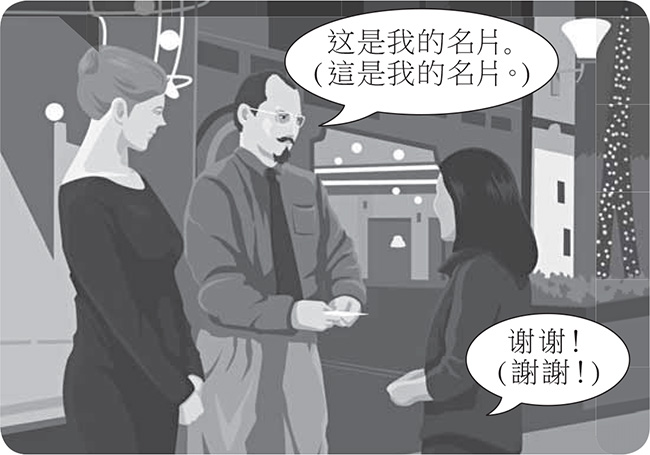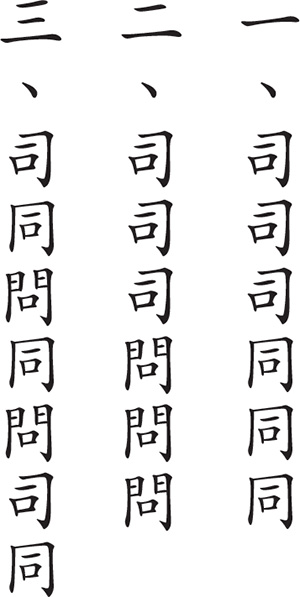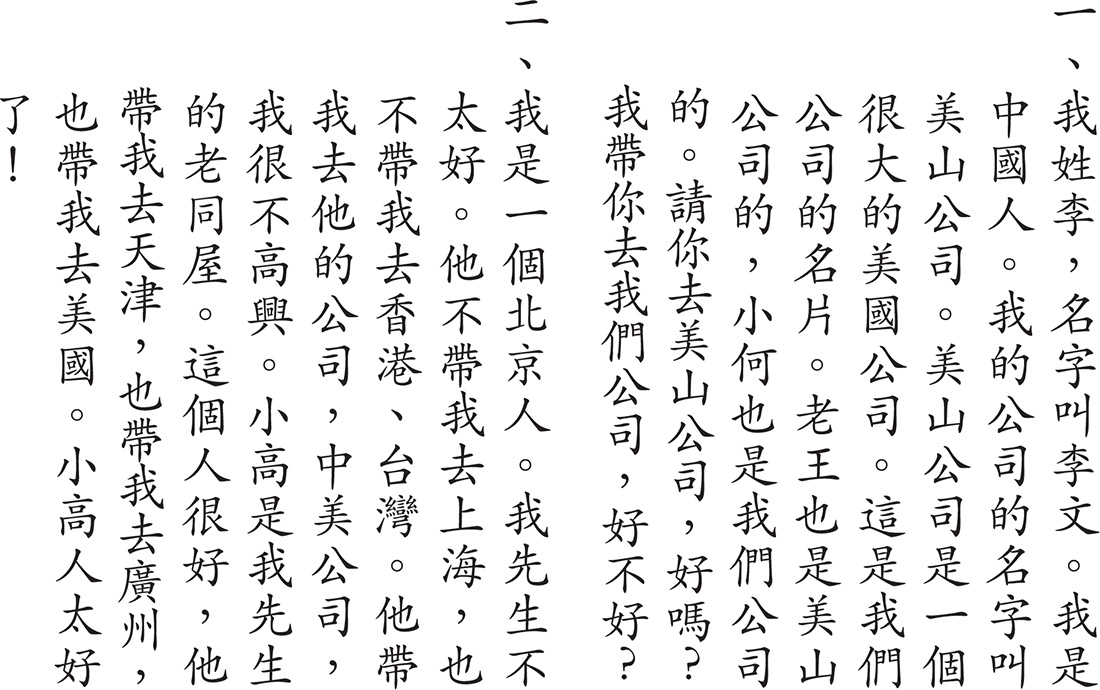PART 4
A Self-introduction

New Characters and Words 
Study the six characters below and the common words written with them, paying careful attention to each character’s pronunciation, meaning, and structure, as well as similar-looking characters. After you’ve studied a character, turn to the Practice Book volume and practice writing it on the practice sheet, making sure to follow the correct stroke order and direction as you pronounce it out loud and think of its meaning.
91 |
片 |
piàn |
flat and thin piece of something |
This character is itself a radical. |
|||
名片 |
míngpiàn |
name card [N] |
|
92 |
没(沒) |
méi |
(indicates past negative of action verbs) |
Radical is 水 shuĭ “water.” Notice that this radical is written 氵 and is referred to colloquially as 三点水(三點水) sāndiăn shuĭ “three drops of water” when it occurs at the left-hand side of a character. Though 没 is now the official simplified character and 沒 is the official traditional character, historically these two characters are alternate versions of the same character. Thus, many writers of traditional characters write this character as in the simplified form. |
|||
没 ( 沒 ) |
méi |
(indicates past negative of action verbs) [AV] |
|
没问 ( 沒問 ) |
méi wèn |
didn’t ask |
|
没带名片 (沒帶名片) |
méi dài míngpiàn |
didn’t bring name cards |
|
93 |
带(帶) |
dài |
take, bring; belt, band, ribbon |
Radical is 巾 jīn “cloth” [BF]. Though “take” or “bring” is the meaning introduced in this lesson, another meaning of this character is “belt.” The top part of this character looks like a belt (一) with various items hanging off it, which someone is “bringing” with him or her. |
|||
带 ( 帶 ) |
dài |
take along, take, bring [V] |
|
94 |
公 |
gōng |
public, official |
Radical is 八 bā “eight.” The component at the bottom is 厶 sī “private” [BF]. Contrast 公 with 去 qù (53), which also contains 厶 sī. |
|||
95 |
司 |
sī |
bureau, department |
Radical is 口 kŏu “mouth.” The whole character is itself a phonetic, e.g., in 饲 (飼) sì as in 饲养 (飼養) sìyăng “feed (animals)” and in 伺 cì as in 伺候 cìhou “serve.” Contrast 司 with 同 (80) and 问 (問) (75). |
|||
司 |
Sī |
Si [SN] |
|
公司 |
gōngsī |
company, firm [N] |
|
96 |
这(這) |
zhè/zhèi- |
this |
Radical is 辶 chuò “walk, go” [BF]. The colloquial name for this radical is 走之 zŏu zhī “the walking 之,” because of its meaning “walk” and its resemblance to the particle 之. Note that, depending on the particular font, this may be written as 辶 or |
|||
这 ( 這 ) |
zhè/zhèi- |
this [PR/SP] |
|
这个 ( 這個 ) |
zhèige |
this, this one |
|
New Words in BMC–SL 2-4 Written with Characters You Already Know 
先生 |
xiānsheng |
gentleman [N] |
太太 |
tàitai |
married woman, lady [N] |
小姐 |
xiáojie |
young lady, unmarried lady [N] |
中美 |
Zhōng-Mĕi |
Sino-American [AT] |
了 |
-le |
(indicates completed action) [P] |
的 |
-de |
(indicates that what precedes describes what follows) [P] |
Reading Exercises (Simplified Characters) 
Now practice reading the new characters and words for this lesson in context in sentences, conversations, and narratives. Be sure to refer to the Notes at the end of this lesson, and make use of the accompanying audio disc to hear and practice correct pronunciation, phrasing, and intonation.
A. SENTENCES
Read out loud each of the following sentences, which include all the new characters of this lesson. The first time you read a sentence, focus special attention on the characters and words that are new to you, reminding yourself of their pronunciation and meaning. The second time, aim to comprehend the overall meaning of the sentence.
一、你好!我叫林山。这是我们公司的名片。
二、美国人不都带名片,中国人也不都带名片吧?
三、李小姐是哪个公司的?她是不是中美公司的?
四、先生,这是您的名片吧?您是不是叫王国中?
五、这是美国 IBM 公司的 CEO 安先生。
六、这是我们公司的谢先生。
七、这是台北中山公司的王小姐。
八、小李没去,小林也没去,他们都没去。
九、我没问,她也没问,我们都没问;你问了吗?
十、大海,请你带我们去你的公司,好吗?
B. CONVERSATIONS
Read out loud the following conversations, including the name or role of the person speaking. If possible, find a partner or partners and each of you play a role. Then switch roles, so you get practice reading all of the lines.
一、
司先生:您好!我姓司。请问,您贵姓?
高先生:我姓高,叫高二明。这是我的名片。
司先生:谢谢!
高先生:司先生,您带名片了吗?
司先生:带了,带了。⋯⋯ 我的名片呢?
二、
美国人:李大文,你好!请坐,请坐。
中国人:谢谢,谢谢!我叫林大文,不叫李大文。
美国人:我没叫你李大文。
中国人:这是我们公司的名片。
美国人:谢谢,这是我的名片。你的公司叫 “大山公司”,是吗?
中国人:不是。我们公司叫 “太山公司”。中文很难吧?
美国人:不难,中文不难!
三、
何先生:小李,这是台生公司的高小姐。
李先生:高小姐,您好!我姓李。这是我的名片。
高小姐:谢谢李先生。我叫高京文。我没带名片。
李先生:高小姐,你们公司很忙吧?
高小姐:是,我们公司很忙。你们公司也很忙吧?
何先生:高小姐,李先生,我先走了!
C. CHARACTER DIFFERENTIATION DRILLS
Distinguish carefully the following similar-looking characters, pronouncing each one out loud and thinking of its meaning.
一、司 司 司 同 同 同
二、司 司 司 问 问 问
三、司 同 问 同 问 司 同
D. NARRATIVES
Read the following narratives, paying special attention to punctuation and overall structure. The first time you read a narrative, read it out loud; the second time, read silently and try to gradually increase your reading speed. Always think of the meaning of what you’re reading.
一、 |
我姓李,名字叫李文。我是中国人。我的公司的名字叫美山公司。美山公司是一个很大的美国公司。这是我们公司的名片。老王也是美山公司的,小何也是我们公司的。请你去美山公司,好吗?我带你去我们公司,好不好? |
二、 |
我是一个北京人。我先生不太好。他不带我去上海,也不带我去香港、台湾。他带我去他的公司,中美公司,我很不高兴。小高是我先生的老同屋。这个人很好,他带我去天津,也带我去广州,也带我去美国。小高人太好了! |
Reading Exercises (Traditional Characters) 
A. Sentences
Read out loud each of the following sentences, which include all the new characters of this lesson. The first time you read a sentence, focus special attention on the characters and words that are new to you, reminding yourself of their pronunciation and meaning. The second time, aim to comprehend the overall meaning of the sentence.

B. CONVERSATIONS
Read out loud the following conversations, including the name or role of the person speaking. If possible, find a partner or partners and each of you play a role. Then switch roles, so you get practice reading all of the lines.

C. CHARACTER DIFFERENTIATION DRILLS
Distinguish carefully the following similar-looking characters, pronouncing each one out loud and thinking of its meaning.

D. NARRATIVES
Read the following narratives, paying special attention to punctuation and overall structure. The first time you read a narrative, read it out loud; the second time, read silently and try to gradually increase your reading speed. Always think of the meaning of what you’re reading.


Entrance to the natatorium at National Taiwan Normal University in Taipei. Notice that the word 游泳馆 (游泳館) yóuyŏngguăn “natatorium” is here written from right to left.
Notes
A3. 李小姐是哪个公司的?她是不是中美公司的?(李小姐是哪個公司的?她是不是中美公司的?) Literally this means “Ms. Li is one from which company? Is she one from Zhongmei Company?” Presumably, in the deep structure of this sentence, there was a noun meaning “person” or “employee,” so that the sentence originally may have been something like “Ms. Li is an employee from which company? Is she an employee from Zhongmei Company?” However, that noun was deleted in the surface structure, leaving only 的 to mean “one from.” In smoother English, we could translate these two questions as “Ms. Li is with which company? Is she with Zhongmei Company?” Instead of “with” you could also say “from”: “Ms. Li is from which company? Is she from Zhongmei Company?”
A5. ORTHOGRAPHIC REPRESENTATION OF FOREIGN BORROWINGS IN CHINESE. This sentence should be rather easy for you to comprehend: 这是美国 IBM 公司的 CEO (這是美國 IBM 公司的 CEO) “This is the CEO of the American IBM company.” Modern Chinese, as written by and for younger urbanites in newspapers, magazines, menus, signs, e-mails, blogs, text messages and so forth, is replete with borrowings from English and other languages that are represented by the letters of the Roman alphabet, sometimes in combination with Arabic numbers. Here are some common examples: CD, DIY, DNA, DVD, ID, IQ, IT, KTV, MP3, MTV, OK, PVC. Some such terms can occur by themselves, but others may be combined with Chinese characters, e.g., B型 B xíng “blood type B,” 3D银幕 (3D銀幕) 3D yínmù “3D screen,” 维生素C (維生素C) wéishēngsù C “vitamin C.” Usually, only upper-case letters are used, but there are a few common borrowings in lower-case letters (e.g., n 次 n cì “an infinite number of times”). Note that, when borrowed into Chinese, each Roman letter or number is considered a separate unit, equivalent to a Chinese character. Obviously, such borrowings are all terms related to modern, foreign-influenced society, not traditional Chinese culture. For that reason, government authorities, Chinese teachers, and other purists often criticize such usage. However, the fact is that most writers of Chinese pay them little heed and go right on using these foreign borrowings. We certainly don’t encourage you to make frequent use of such borrowings in your own written (or, for that matter, spoken) Chinese. However, since this textbook attempts to present written Chinese as actually used today, we do include a few such borrowings in the reading exercises.
A6. 这是我们公司的谢先生 (這是我們公司的謝先生) “This is Mr. Xie from our company.”
A10. 请你带我们去你的公司 (請你帶我們去你的公司) “Please take us to your company.” Note that the verb 带 (帶) can be used to mean “take” or “bring” things or, as here, people.
B1. 您带名片了吗?(您帶名片了嗎?) “Did you bring a name card?”
B2. Examine the last line by the Chinese speaker: 我们公司叫 “太山公司” (我們公司叫 太山公司) “Our company is called ‘Taishan Company.’” In this sentence, 我们公司 (我們公司) means “our company,” but why is there no 的 between 我们 (我們) and 公司? The answer is that, though it would not be grammatically incorrect to say 我们的公司 (我們的公司), very often in Chinese a 的 is dropped when there is an especially close connection between a pronoun and a noun, especially when it involves a phrase that is said with high frequency. This holds true for body parts (“my hand”), for relatives (“my mother”), and—as we see here—for institutions to which there is a strong sense of belonging (“our company,” “our school,” etc.). Also, note that the speaker says not “my company” but, rather, “our company.” This is related to the strong sense of group affiliation in Chinese society as compared to the more individual outlook in Western society.
B3. 你们公司 (你們公司) “your company.” Grammatically, this is like 我们公司 (我們公司) in B2 above.
D1. 老王也是美山公司的,小何也是我们公司的 (老王也是美山公司的,小何也是我們公司的) “Old Wang is also with Meishan Company, and Little He is also with our company.” Grammatically, these two clauses are like A3 above.
D2. Look at the word 人 in 小高人太好了. This 人 here means not just “person” but “as a person” or, even more specifically, “the manner in which a person conducts herself or himself.” We could translate the whole sentence as “Little Gao, as a person, is too good” or, in better English, “As a person, Little Gao is wonderful.” Of course, given the context of this paragraph, we would have to conclude that this is a very subjective view of Little Gao!
 . The other component of the simplified character is
. The other component of the simplified character is